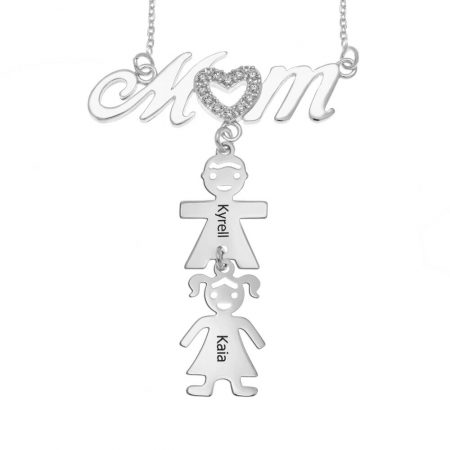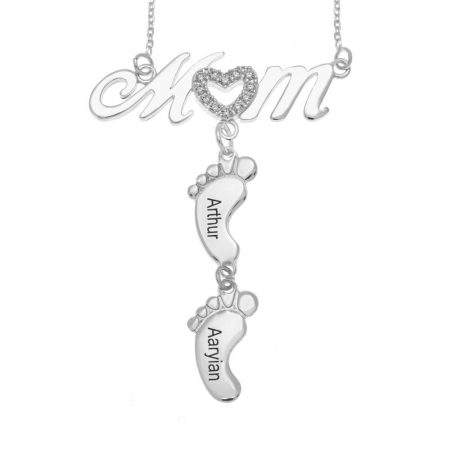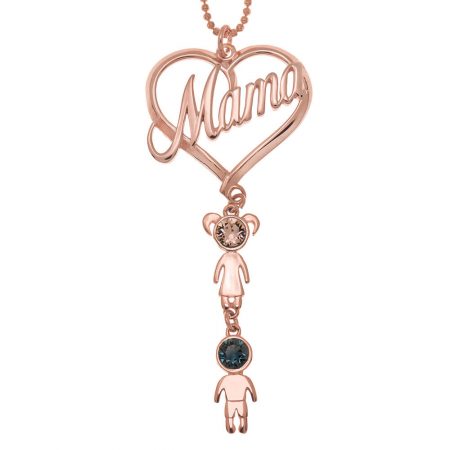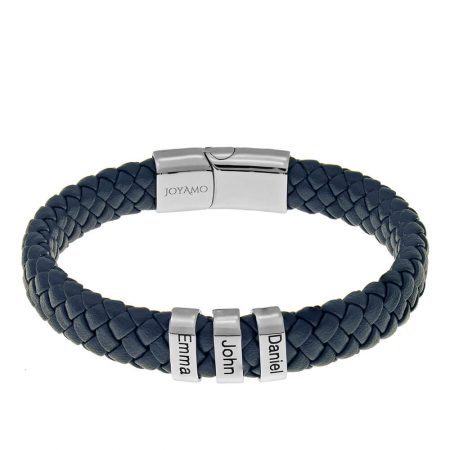In the magic world of gemstones, few hold the illustrious allure and endless charisma of the July birthstone: the ruby.
Radiating passion, power, and prestige, the ruby stands as a representation of vitality in the heart of summer.
As the ideal gemstone for those born under the sign of Cancer (June 21 – July 22), the ruby has a tale of ancient mystique and modern admiration.
Traditionally, the ruby has captivated civilizations with its vibrant crimson hues and symbolic significance.
Adored by cultures worldwide as a stone of nobility and divine favor, rubies have adorned the crowns of kings and the regalia of emperors, embodying strength, prosperity, and protection.
Its name, derived from the Latin word “ruber,” meaning red, evokes visions of passion and courage, stirring the soul with its intense vibrancy.
In astrology, the ruby resonates deeply with the dynamic energies of Cancer.
Cancer, represented by the nurturing crab, cherishes familial bonds and emotional security.
The ruby’s association with love, devotion, and harmony aligns harmoniously with Cancer’s nurturing spirit, offering strength and protection to those under its celestial influence.
Beyond its astrological significance, the ruby holds profound metaphysical properties, believed to stimulate the heart chakra and ignite the fires of passion within the soul.
It is considered a stone of vitality, encouraging courage, ambition, and spirit.
Worn as a talisman of love, a symbol of strength, or a token of prosperity, the ruby stands as a timeless emblem of July-born individuals, eternally entwined with the essence of their celestial journey.
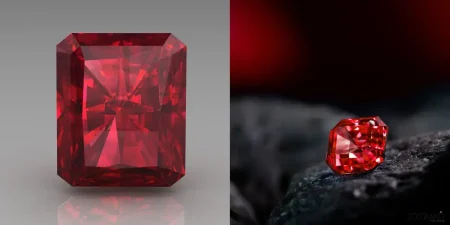
1) History and origins of ruby
The history and origins of rubies are steeped in a tapestry of stories spanning across centuries and reaching every corner of the world.
The tale of rubies takes us on a journey through myths, royal intrigues, and cultural traditions.
The earliest known references to rubies can be traced back to Sanskrit texts where they were revered as the “king of stones” known as “ratnaraj.”
These ancient texts like the Rigveda and Atharvaveda celebrated rubies as gems attributing them to divine powers and mystical meanings.
In Hindu mythology, rubies were connected to Surya, the sun god, symbolizing vitality, strength, and protection.
In civilizations such as Egypt, Greece, and Rome rubies were highly prized by royalty, nobility, and religious figures.
The ancient Egyptians believed that rubies offered protection against forces and misfortune; hence they often incorporated them into their armor and talismans.
The Greeks and Romans associated rubies with Mars, the god of war, believing that wearing these gemstones would bestow courage and strength in battle.
Throughout the Middle Ages, the fascination with rubies endured among Europe’s class and clergy.
Rubies were often used to embellish the regalia of kings and queens representing authority, affluence, and divine blessings.
The famous Black Princes Ruby, a ruby embedded with a spinel, has been a part of the British Crown Jewels for generations and its deep red glow recounts stories of bravery and triumph.
In the traditions of cultures, rubies were held in high esteem as amulets for safeguarding and prosperity.
In Burma ( Myanmar) the Mogok Valley gained renown for producing some of the world’s exceptional rubies, prized for their rich color and remarkable clarity that adorned the treasures of monarchs and maharajas across Asia.
Over centuries, the enchantment of rubies has transcended boundaries and societies becoming intertwined with civilization through its timeless grace and enduring allure.
Today rubies remain highly valued as symbols of affection, desire, and authority sought after by collectors, enthusiasts, and royalty.
In gemology circles, rubies are prized not only for their appearance but also for their scarcity and resilience.
As a type of corundum gemstone, rubies acquire their color from chromium presence which gives them their distinct hue.
Rubies can be discovered in parts of the globe such as Thailand, Sri Lanka, and Tanzania.
However, Burma is widely known for its top-notch rubies, with the Mogok Valley standing as a symbol of the lasting charm of these exquisite gemstones.
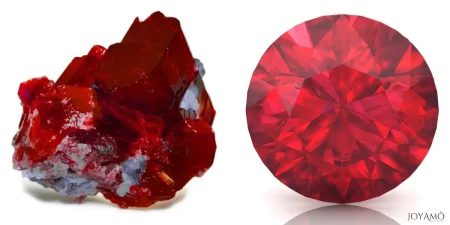
2) Ruby geological formation and major mining locations
The process of how rubies are formed in the Earth’s crust is truly captivating.
It all begins underground where a mix of heat, pressure, and mineral-rich conditions combine to create these sought-after gemstones.
Rubies are part of the corundum family mainly made up of aluminum oxide with a hint of chromium giving them their striking hue.
These precious gems usually take shape in environments over millions of years due to the heat and pressure that alter existing rocks and minerals.
One known spot where rubies form is within marble deposits found within metamorphic terrains.
Here limestone or dolomite rocks undergo changes from heat and pressure allowing corundum crystals to develop under the right circumstances.
After the molten rock cools down and hardens rubies start to form within the marble structure often appearing in veins or pockets alongside minerals like spinel, garnet, and quartz.
Another important location for ruby formation is in volcanic areas.
In these places, rubies can emerge within chambers or volcanic debris deposits when volcanic processes bring corundum rocks closer to the surface.
The quick cooling process allows rubies to solidify into high-quality specimens occasionally discovered in riverbeds or alluvial deposits after crystallizing.
Ruby mining occurs in locations in each region adding to the diversity of these precious gemstones.
The Mogok Valley, in Burma (Myanmar), stands out as a ruby-producing area with a history spanning over a millennium.
Its distinct geological features such as marble deposits and volcanic influences have led to the discovery of top-quality rubies known for their color, clarity, and fluorescence.
Apart from Burma, ruby mining regions include Thailand, Sri Lanka, Cambodia, and Tanzania.
Thailand’s Chanthaburi and Trat provinces have been hubs for ruby trade and processing for years, drawing gems from Thai Cambodian border sites.
Sri Lanka (Ceylon) has its legacy of ruby mining across alluvial deposits and metamorphic landscapes throughout the island.
In East Africa, Tanzania has emerged as a player in the ruby market with valuable deposits located in the Umba Valley and Morogoro region.
Tanzanian rubies showcase an array of hues and characteristics similar to the Burmese rubies in terms of quality and allure.
The creation of rubies through processes showcases the wonders of Earth’s natural phenomena with various global mining sites consistently providing these valuable gemstones to cater to the needs of collectors, jewelers, and passionate individuals worldwide.
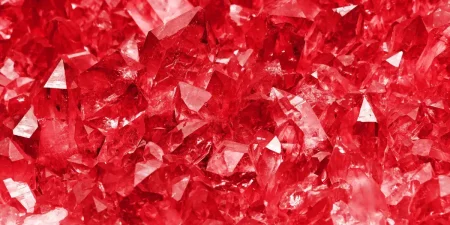
3) Physical properties of the Ruby
Rubies are widely admired for their beauty and lasting appeal showcasing a range of characteristics that set them apart as some of the most coveted gemstones globally.
Their vibrant red color and exceptional hardness contribute to their allure and popularity.
The red hue of rubies varying from crimson to lively scarlet is a standout feature attributed to the presence of chromium in the crystal structure of the corundum mineral.
This distinct color is a result of how chromium interacts with light-absorbing wavelengths while allowing others to pass through creating the red shade associated with rubies.
The intensity and purity of this hue play a role in determining the value and desirability of a ruby with vivid evenly distributed colors highly sought after by collectors and enthusiasts.
Alongside their captivating coloration,n rubies are recognized for their hardness scoring 9 on the scale of mineral hardness.
This exceptional durability makes rubies highly resistant to scratches and wear positioning them below diamonds in terms of toughness.
Their superior hardness ensures that rubies can withstand use without losing their luster, making them an excellent choice for jewelry pieces like rings, earrings, necklaces, and bracelets.
When expertly cut and polished, rubies also showcase transparency and clarity that enhances their elegance.
However similar to all gemstones, rubies may contain imperfections or inclusions within their crystal structure which can impact how they look and their value.
Some rubies exhibit a phenomenon called asterism where needle-like inclusions form a star-shaped pattern known as a “star ruby” when seen under light.
Another notable characteristic of rubies is their fluorescence where the gemstone emits light when exposed to radiation.
Many rubies glow with an orange-red hue under ultraviolet light adding to their charm and mystery.
Moreover, rubies have a high refractive index causing them to bend and reflect light in an exceptionally striking way.
This optical feature enhances the brilliance and sparkle of rubies giving them a captivating luminosity that distinguishes them from other gemstones.
In summary, the physical attributes of rubies, including their color, remarkable hardness, transparency, fluorescence, and optical brilliance come together to create gemstones of immense beauty and worth.
Gracing jewelry pieces like incredible birthstone necklaces and stunning birthstone rings, as cherished as symbols of love and passion, rubies continue to enchant gemstone enthusiasts all over the world.
Physical properties of the Ruby
| Property | Description |
|---|---|
| Color | Intense red hue, ranging from deep crimson to scarlet |
| Hardness | 9 on the Mohs scale, making rubies highly durable |
| Transparency | Exhibits excellent transparency and clarity |
| Inclusions | May contain inclusions or imperfections |
| Fluorescence | Fluoresces with a vivid red or orange-red glow |
| Refractive Index | High refractive index enhances brilliance and sparkle |
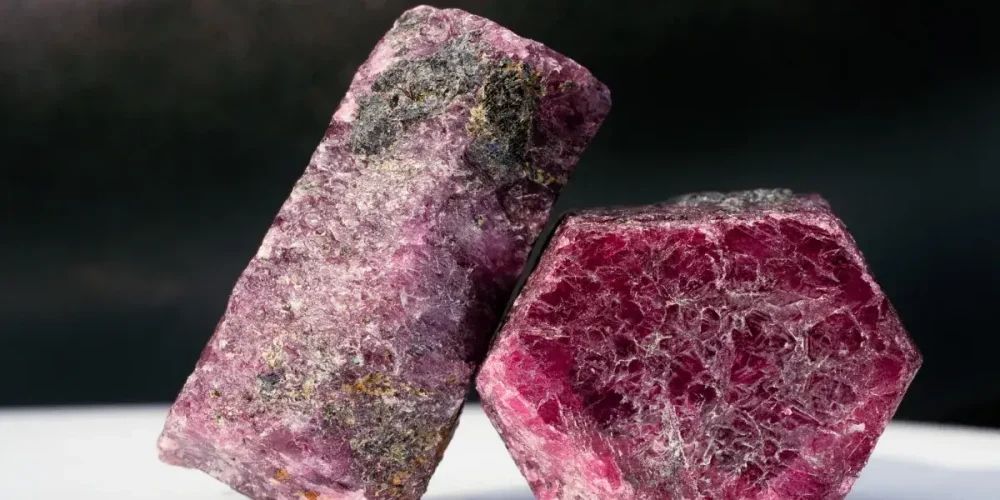
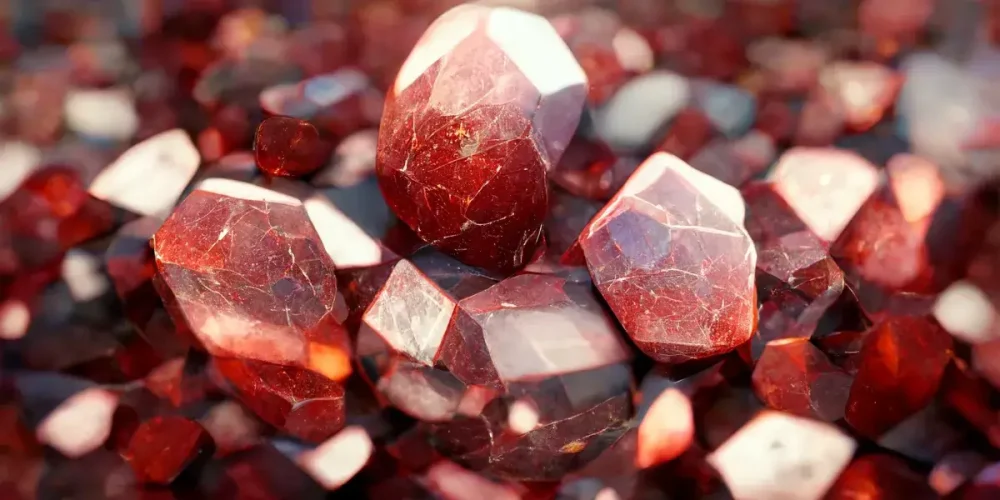
4) Symbolism and Meanings Associated with Ruby
Throughout cultures and civilizations, rubies have carried symbolic meanings and deep significance.
Known as the gemstone of passion and strength, rubies represent love, vitality, and power.
In societies, they were closely linked to the sun’s life-giving energy embodying courage, vitality, and divine blessings.
The radiant red color of rubies has connected them to matters of the heart and emotions making them emblematic of love, passion, and romance.
Across history, rubies have been revered as talismans believed to shield against forces and ill fate.
Their vivid hue and durability symbolized invulnerability and fortitude making them treasured possessions among warriors and rulers alike.
Beyond their nature, rubies have been associated with prosperity and abundance signifying wealth, success, and good luck.
At times, rubies retain their profound symbolism often exchanged as gifts for occasions like anniversaries, engagements, and birthdays.
Their timeless beauty and enduring charm serve as reminders of the emotions and lasting connections that bind us to one another and the world around us.
Whether treasured as symbols of love, protection, or prosperity, rubies remain cherished gemstones that carry profound meanings and inspire awe and admiration wherever they are found.
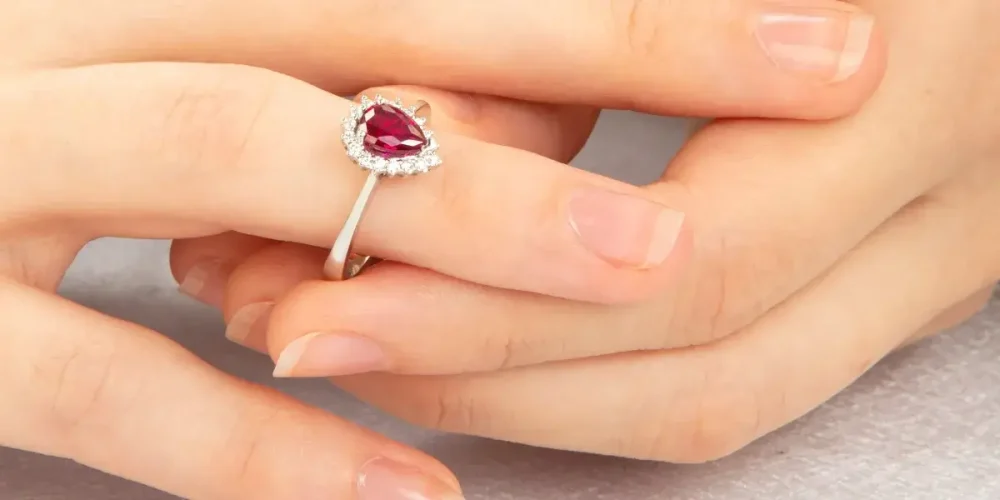
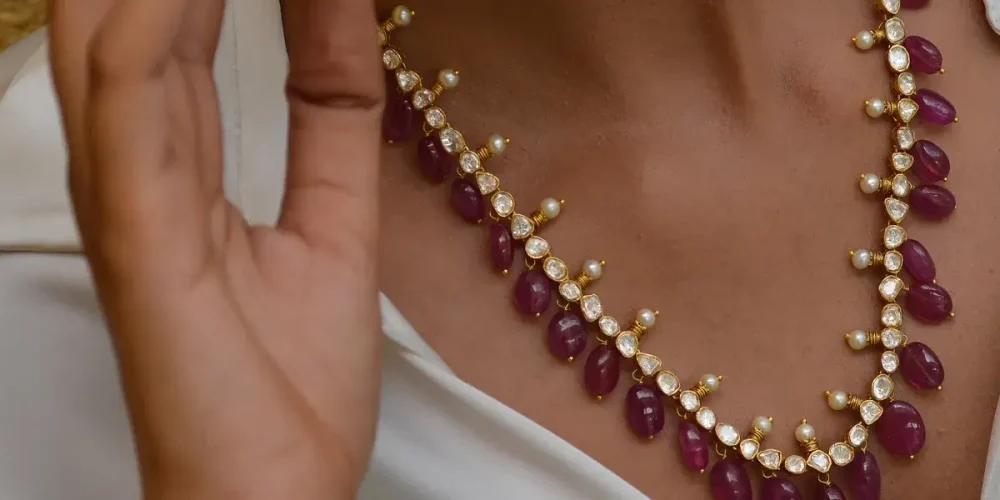
5) Metaphysical and Healing Properties of Ruby
Beyond their appearance, rubies are believed to hold spiritual and healing attributes that resonate with the mind, body, and soul.
Metaphysically, rubies are linked to the root chakra which is associated with feelings of security, stability, and grounding.
It is believed that by activating the root chakra, rubies can boost energy levels, instill courage, and foster a sense of connection and belonging in individuals.
The healing properties ascribed to rubies encompass a spectrum of emotional and spiritual well-being.
Physically, these gemstones are thought to support heart health and blood circulation by purifying the blood and strengthening functions.
Emotionally, rubies are said to promote passion, enthusiasm, and self-assurance, empowering individuals to pursue their aspirations with bravery and resolve.
Spiritually, rubies are believed to deepen one’s bond with love and wisdom while enhancing clarity and purpose.
Worn as adornments, kept close as symbols of protection, or utilized during meditation practices for aligning energies, rubies hold a place for their capacity to elevate spirits through hopefulness, rejuvenation, and positive transformation.
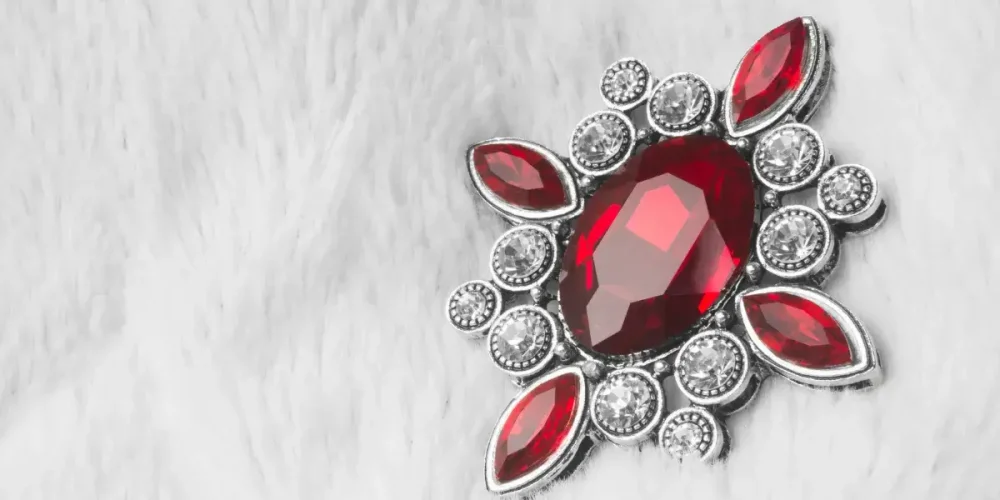
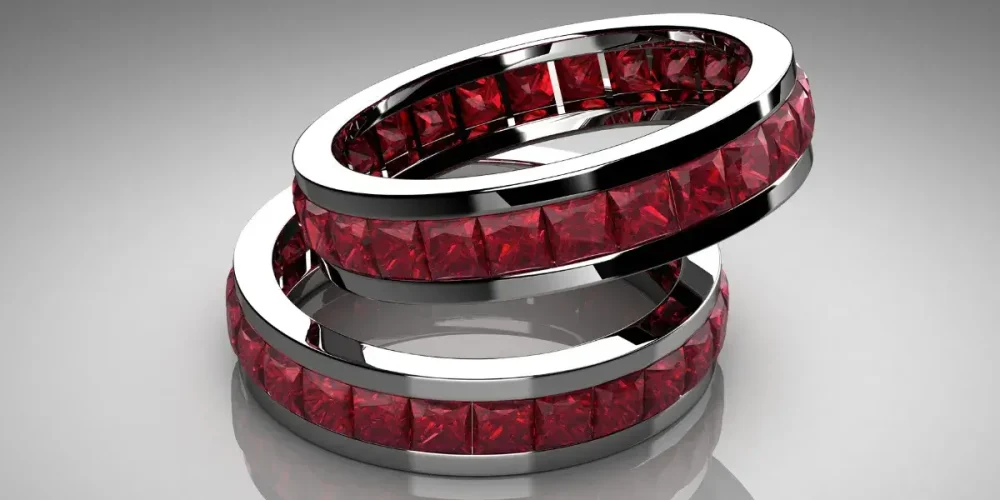
6) Notable ruby gemstones and Jewelry Pieces
Rubies have been a part of some of the most cherished jewelry pieces in history, highlighting their timeless beauty and enduring charm.
One remarkable ruby gem is the Black Princes Ruby, a ruby embedded with spinel that sits at the heart of the Imperial State Crown of the United Kingdom.
It is said to have been acquired by Edward, Prince of Wales (known as the “Black Prince”) during the 14th century and has since been passed down through generations of monarchs, symbolizing power, authority, and royal heritage.
Another renowned ruby is the Sunrise Ruby, a gemstone weighing over 25 carats Originally mined in Myanmar.
Recognized for its hue and exceptional clarity the Sunrise Ruby fetched a groundbreaking price at auction solidifying its position as one of the most valuable rubies worldwide.
Adorned in a ring crafted by jewelry designer Cartier, the Sunrise Ruby embodies the classic sophistication and opulence associated with ruby jewelry.
Among other ruby jewelry pieces are the Burmese Ruby Tiara worn by Queen Elizabeth II of Britain and Elizabeth Taylor’s Ruby and Diamond Necklace; both showcasing the exquisite artistry and allure of rubies in high-end jewelry.
Rubies, whether they are worn as crowns, tiaras, or bold necklaces, never fail to mesmerize and delight jewelry lovers with their charm and enduring appeal.
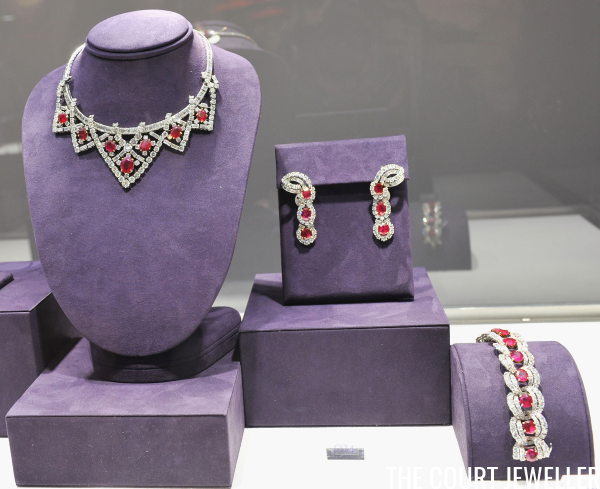


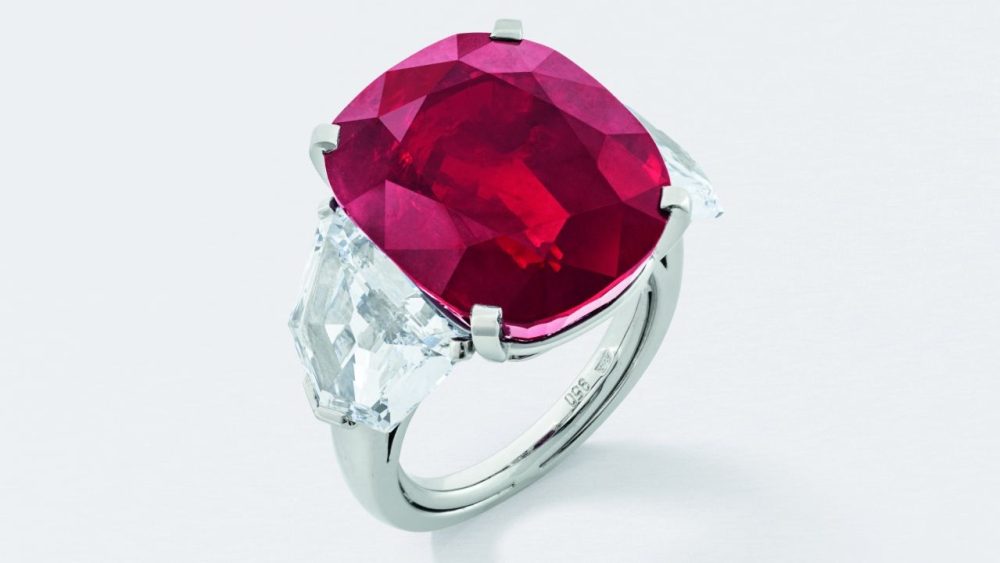
7) Tips for caring for Ruby jewelry
Taking care of ruby jewelry is important to maintain its timeless beauty and durability.
Below are some important tips:
- Gentle Cleaning: Regularly clean your rubies using a lint cloth to eliminate dirt and oil buildup. Avoid using chemicals or abrasive cleaners that could harm the gemstone or its setting.
- Prevent Impact: While rubies are strong they can still get scratched from impacts. It’s best to store your ruby jewelry to prevent any scratches and avoid wearing it during activities that involve a lot of movement.
- Proper Storage: Keep your ruby jewelry in a jewelry box or pouch lined with fabric to shield it from scratches and moisture. You may also want to wrap each piece in tissue paper to prevent them from rubbing against each other.
- Temperature Caution: Extreme heat can affect the color and clarity of rubies while extreme cold can cause them to crack. Make sure to remove your ruby jewelry before exposing it to high temperatures like bathtubs or saunas and store it away from direct sunlight.
- Professional Care: It’s advisable to have your ruby jewelry checked by a jeweler for loose stones or damaged settings. They can also provide cleaning and polishing services to bring back its shine.
By adhering to these maintenance suggestions you can keep your ruby accessories looking stunning and exquisite for years safeguarding their charm and worth, for the pleasure of generations to come.
July Birthstone and the Zodiac: CANCER
The July birthstone, the ruby, shares a profound connection with the zodiac sign Cancer, which spans from June 21 to July 22.
Cancer, symbolized by the crab, is known for its nurturing and empathetic nature, deeply rooted in emotions and familial bonds.
Similarly, the ruby embodies qualities of passion, love, and protection, making it a perfect match for those born under the sign of Cancer.
Just as Cancer individuals are fiercely protective of their loved ones, rubies are often associated with strength and vitality, believed to provide a shield against negative energies and harm.
This protective quality resonates with Cancer’s instinct to safeguard their inner circle and create a sense of security and belonging.
Also, rubies are symbolic of passion and emotional intensity, mirroring Cancer’s deep sensitivity and capacity for love.
Like the ruby’s vibrant red hue, Cancer individuals exude warmth, affection, and loyalty, forming deep emotional connections with those they care about.
In essence, the ruby serves as a talisman for Cancer natives, embodying the essence of their nurturing spirit, protective instincts, and profound emotional depth.
As they journey through life, those born under the sign of Cancer can draw strength and inspiration from the radiant energy of the ruby, embracing their innate qualities with courage and compassion.
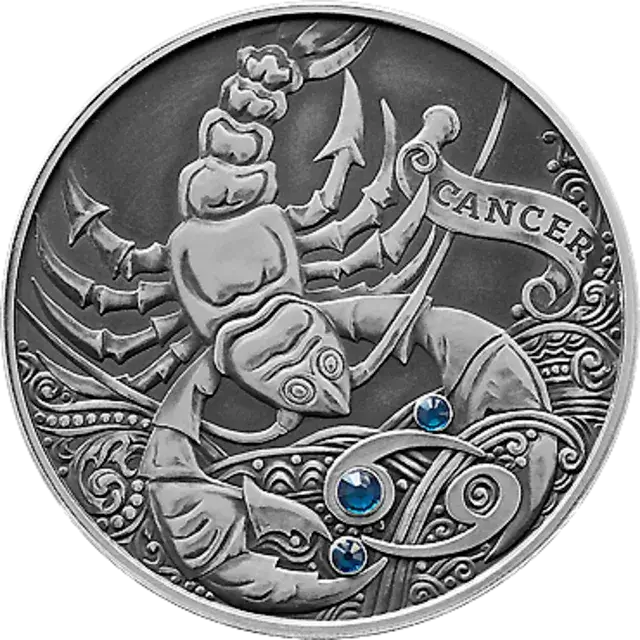

💡 What is July’s birthstone FAQs
✔ Are the two birthstones for July?
Yes, July is linked to the ruby and the pearl, as its birthstones.
✔ What is July birthstone color?
The primary birthstone for July, the ruby, is known for its intense red color.
✔ What is the color of the month of July?
The color associated with the month of July is often described as a vibrant red, in harmony with the ruby’s hue.
✔ Is the peridot the birthstone for July?
No, peridot is not the birthstone for July. Peridot is the birthstone for August.
✔ What is the rarest birthstone month?
There isn’t a single “rarest” birthstone month, as rarity can vary depending on factors such as availability, demand, and cultural significance.
✔ What month have two birthstones?
Several months have two birthstones. For example, October has opal and tourmaline.
✔ Why does October have two birthstones?
The tradition of having multiple birthstones for a month allows for greater variety and personalization in birthstone jewelry. In the case of October, opal and tourmaline are both celebrated as birthstones to offer individuals born in October a choice between these two unique gemstones.
✔ How does the birthstone ruby form?
Rubies form under high temperature and pressure conditions within the Earth’s crust, often in metamorphic environments such as marble deposits or volcanic regions. The presence of chromium within the crystal lattice of the corundum mineral gives rubies their characteristic red color.
 SHIPPING
SHIPPING

